在美国,多种维生素/多种矿物质补充剂的使用与微量营养素摄入量和生物标志物的增加以及缺乏症和缺乏症的发生率降低有关
Q3 Medicine
Journal of Nutrition in Gerontology and Geriatrics
Pub Date : 2019-09-10
DOI:10.1080/21551197.2019.1656135
引用次数: 19
摘要
微量营养素缺乏在老年人中很常见,使用复合维生素/多矿物质补充剂(MVM)可以改善他们的营养状况。分析国家健康和营养检查调查数据,以确定年龄≥51岁的成年人基于饮食和MVM使用的微量营养素摄入量。使用营养生物标志物评估缺陷。国家癌症研究所的方法被用来估计18种微量营养素的日常摄入量,按年龄和使用MVM的频率进行分层。与单独食用食物相比,MVM的使用与更高的营养素摄入量和更低的几乎所有微量营养素不足的发生率有关,并改善叶酸、碘、硒、维生素B6、B12和D的营养生物标志物状态。定期使用MVM(≥16天/月)降低了维生素B6和D临床缺乏(由生物标志物状态定义)的几率,但增加了超过可耐受的叶酸摄入量上限的比例。维生素B6缺乏症在不服用MVM的人群中很常见,并且随着年龄的增长而增加。本文章由计算机程序翻译,如有差异,请以英文原文为准。
Multivitamin/Multimineral Supplement Use is Associated with Increased Micronutrient Intakes and Biomarkers and Decreased Prevalence of Inadequacies and Deficiencies in Middle-Aged and Older Adults in the United States
Abstract Micronutrient inadequacies are common in older adults and using a multivitamin/multimineral supplement (MVM) may improve their nutritional status. National Health and Nutrition Examination Survey data were analyzed to determine micronutrient intakes based on diet and MVM use in adults aged ≥51 years. Deficiencies were evaluated using nutrient biomarkers. The National Cancer Institute Method was used to estimate usual intakes of 18 micronutrients stratified by age and frequency of MVM use. Compared with food alone, MVM use was associated with higher nutrient intake and lower prevalence of inadequacies of almost all micronutrients examined and improved nutrient biomarker status of folate, iodine, selenium, and vitamins B6, B12, and D. Regular MVM use (≥16 days/month) decreased the odds of clinical deficiency (defined by biomarker status) of vitamins B6 and D but increased the proportion exceeding the tolerable upper intake level of folic acid. Vitamin B6 deficiency in MVM non-users was common and increased with age.
求助全文
通过发布文献求助,成功后即可免费获取论文全文。
去求助
来源期刊

Journal of Nutrition in Gerontology and Geriatrics
Nursing-Nutrition and Dietetics
CiteScore
2.20
自引率
0.00%
发文量
13
期刊介绍:
The Journal of Nutrition in Gerontology and Geriatrics publishes original research studies that are directly relevant to clinical and community nutrition issues that affect older adults. Epidemiologic and community-based studies are suitable for JNE, as are well-controlled clinical trials of preventive and therapeutic nutritional interventions. The Journal of Nutrition in Gerontology and Geriatrics invites papers on a broad array of topics in the nutrition and aging field, including but not limited to studies of: preventive nutrition, nutritional interventions for chronic disease, aging effects on nutritional requirements, nutritional status and dietary intake behaviors, nutritional frailty and functional status, usefulness of supplements, programmatic interventions, transitions in care and long term care, and community nutrition issues.
 求助内容:
求助内容: 应助结果提醒方式:
应助结果提醒方式:


